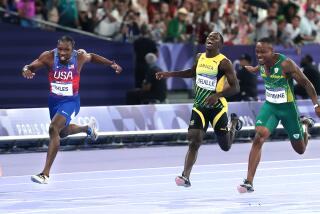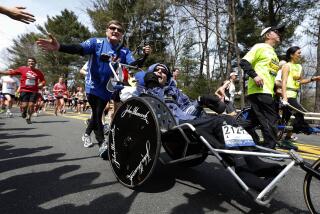Rod Dixon to Wear Camera on His Head During Today’s New York City Marathon
- Share via
As the field in the New York City Marathon departs from the Verrazano Bridge and heads up 4th Avenue in Brooklyn, a man wearing a hockey helmet and a carpenter’s belt suddenly will burst into the lead pack. He’ll stay with the leaders for about a mile, then drop out.
He will return to the race three more times for about the same distance, then withdraw, each time with full approval from race organizers and officials.
This isn’t the kind of behavior one might expect from Rod Dixon, a world-class runner who won the New York Marathon in 1983. But Dixon is part of a grand experiment which he feels could have a profound impact on his sport.
Dixon will wear ABC’s mini-camera, attached to a hockey helmet, as he runs in portions of the race. A small microphone also will be attached to the helmet.
“I went to ABC about the race,” said Dixon, who has taken off from competition for most of 1985. “I said that commentary had been done before, but if there was a chance to bring a new dimension or perspective to my sport, I’ll do it.”
The mini-camera could provide just that. It received raves when first used by ABC at the Little League World Series in August, when it was attached to the facemask of the home plate umpire.
“I see the race from a runner’s view; most people see it from a spectator’s view. Hopefully, you will be able to see the race from my eyes now,” says Dixon. “You will understand what is going on out there all the time, the positioning . . . looking five or six moves ahead.
“I want to tell why a runner looks strong or why he seems to be weakening. You might sit in a studio and see these but you can really only get the feel for it with you are running along with them.”
Curt Gowdy Jr., who will produce ABC’s coverage of the marathon, says Dixon is the perfect candidate to wear the five pounds of equipment while keeping keep pace with the leaders.
“He came to me and asked if there was any role he could take in the marathon,” Gowdy said. “I said no, but if something develops where we could use someone of his stature, we would call him.
“When we took the step forward with the runner’s helmet camera, we asked if Rod would try it out and test it. He was the perfect choice. Rod is a big name in the sport and that is important.
“The signal is received by the men’s lead vehicle. In order to receive it, Rod has to be approximately within 200 yards of the vehicle. We needed someone who could run a 4:35 pace with five pounds of equipment. Rod is aware of how to run with a pack. He will not be in front of the leaders. The guidelines are that he will be very cognizant of the runners.”
That’s no problem for Dixon. He fully understands the boundaries of the job.
“If a runner knows about things beforehand and nothing foreign is introduced, then there’s no problem,” he says. “I’ll discuss it with many of them before the race and find out how they feel about my being there and possibly talking to them.
“In racing, if you can break a competitor’s concentration, it’s an upsetting thing and can cause him to lose his pace and balance. I don’t want to do that, so I’ll be careful not to interfere.”
Aside from the use of the minicamera, ABC will strap a heart pulse monitoring device to Bill Rodgers, a four-time winner of the race. Dr. Paul Thompson, an expert in cardiology, will be in the studio to evaluate Rodgers’ heart rate throughout the race.
More to Read
Go beyond the scoreboard
Get the latest on L.A.'s teams in the daily Sports Report newsletter.
You may occasionally receive promotional content from the Los Angeles Times.










